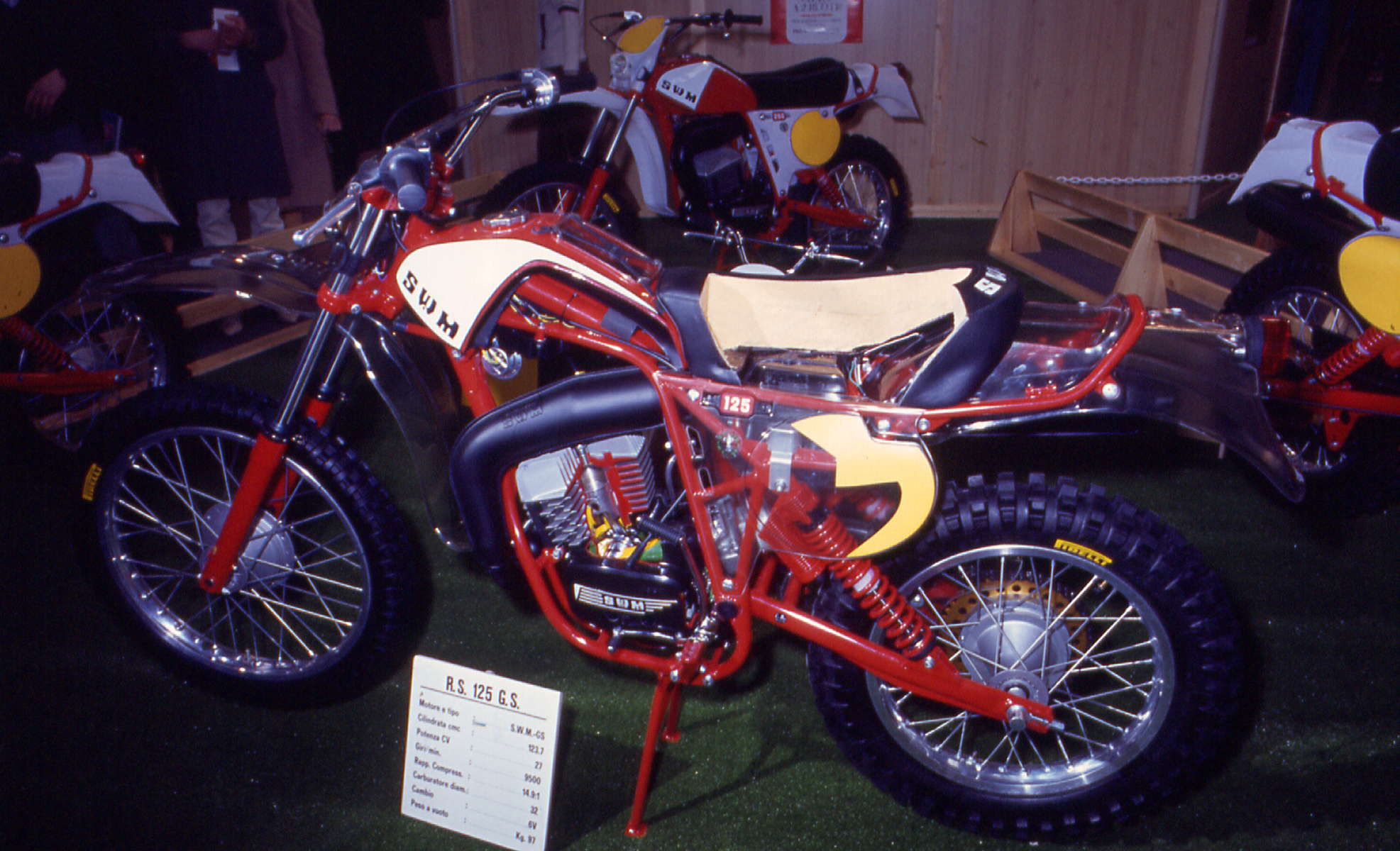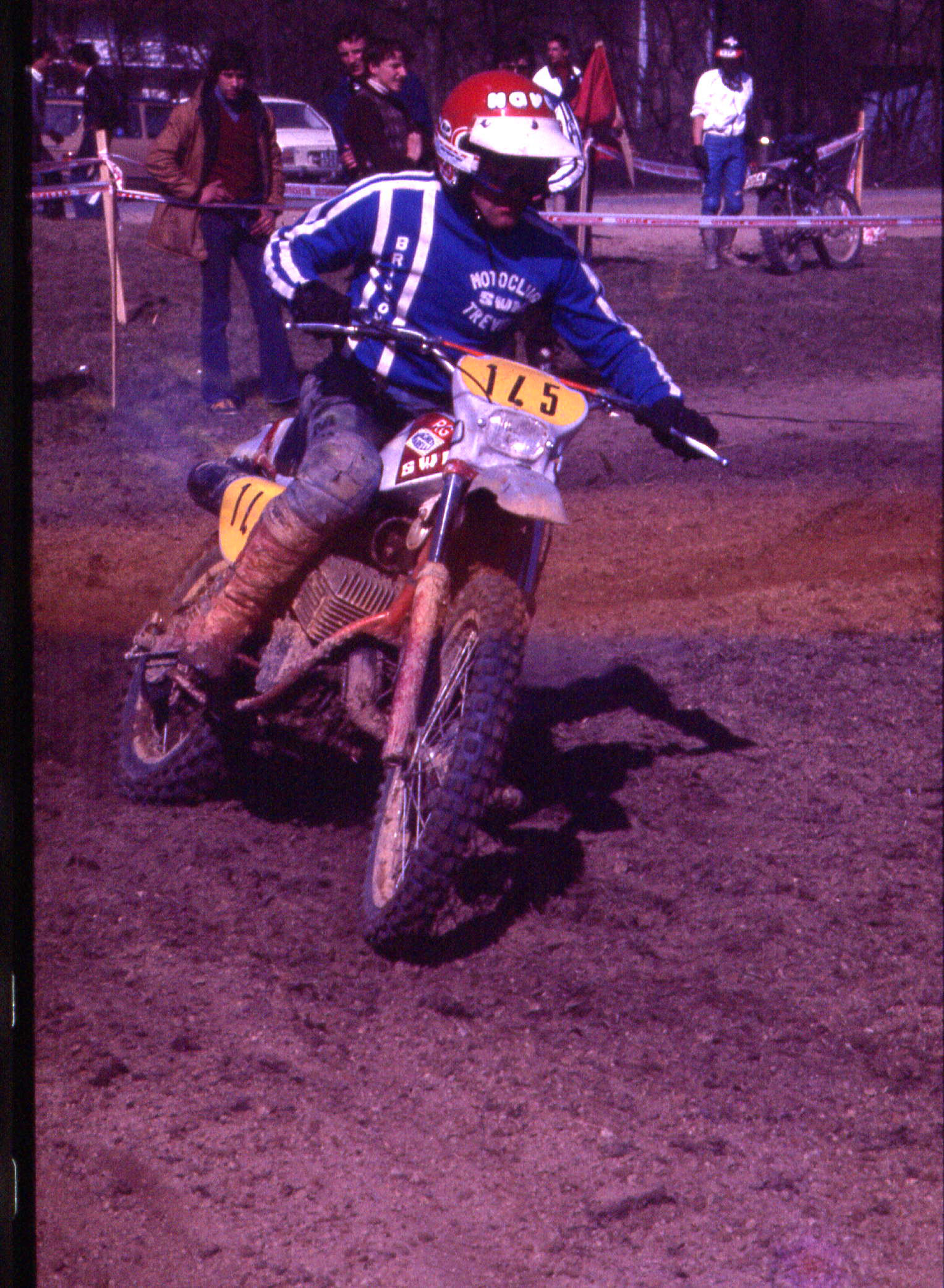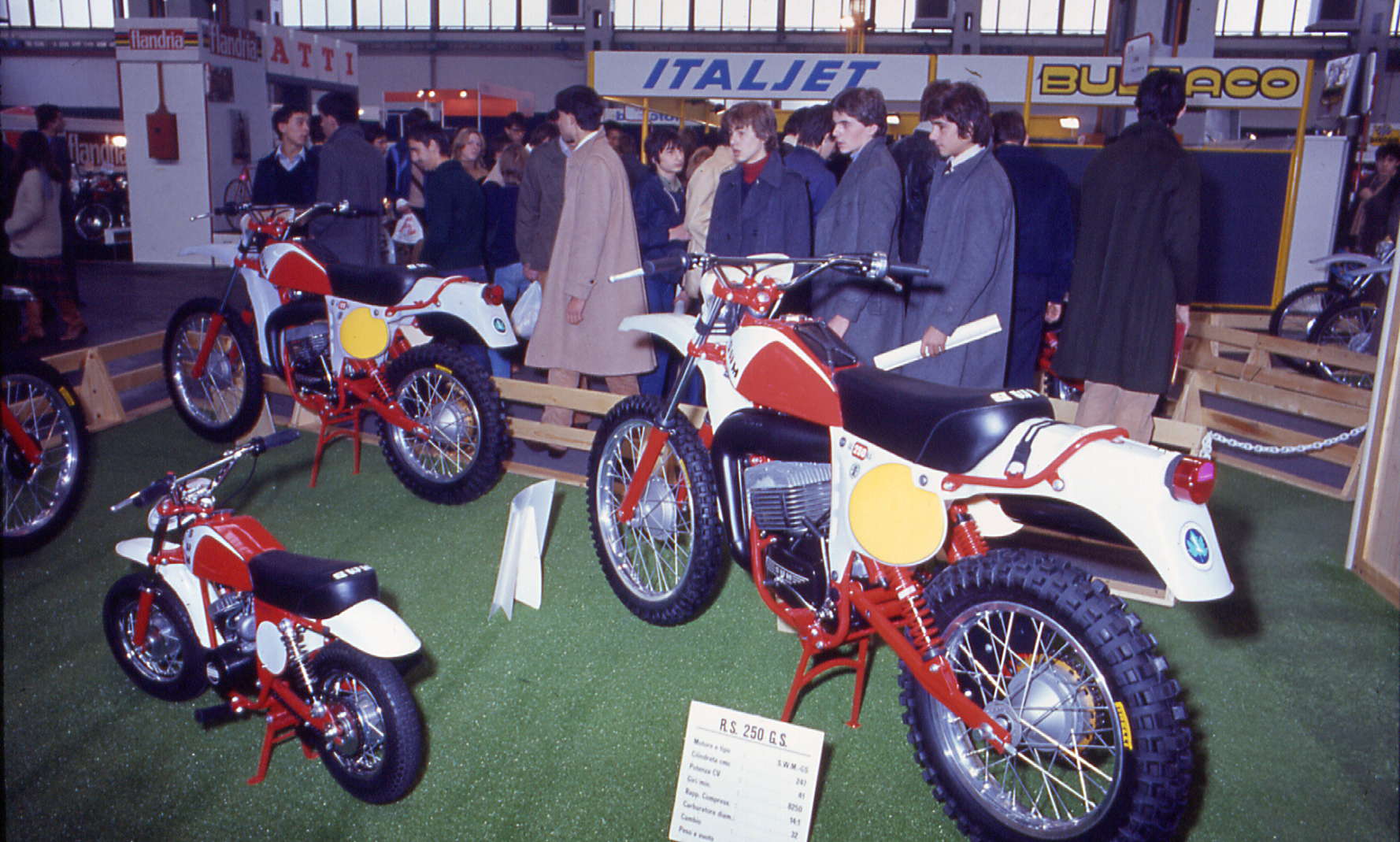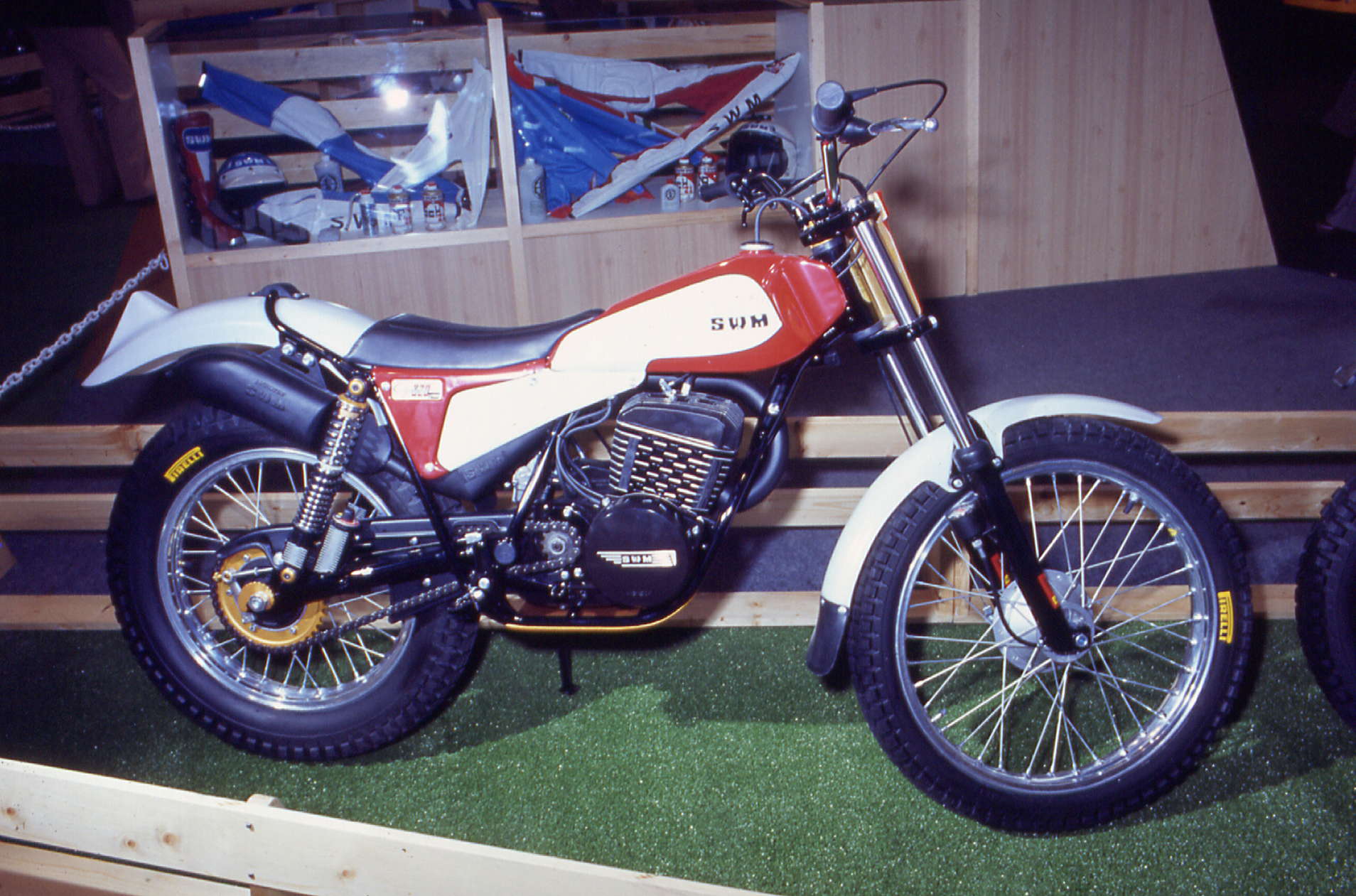SWM HISTORY 3




On the threshold of 1977, during his sixth life’s year, SWM was by then one of the most important firm of the sector with a discreet production and a good competitive past. At that point needed some important decisions: going on with the current production of motorbikes relative to the utilize of the Sachs’ motors, that hadn’t cantered all the pre-arrange objects and they didn’t guarantee the best perspectives for the future, or finding new stimulating roads?
The realization of a motor from SWM was a feasible thing in a technical sense but not totally in a practical sense because it would have committed many energies taking off time and money from the fast development that the firm was facing. They thought of finding a new partner in a position to provide a motor and a service more suitable to the demands of the SWM that would have been capable of satisfy soon the requests and the development. After a careful analysis of the market, they opted for the Austrian Rotax, division of the Canadian Bombardier that for this one produced motors and some parts used on their production of motorbikes and snowmobiles. These motors already used since two years by the compatriot Puch had demonstrated a good credibility but for the use from SWM, they needed a further a streaming, alleviation and a rationalization, demands in which Rotax was arranged to supply his collaboration, seeing also the intention of SWM of entering in the trial sector.
The coming out of the new rotating valve’s motors, in which Vergani believed because he had some preceding experiences during his permanence in Gilera, gave a new creative pressure at the SWM’ staff digging out a new range of motorbikes very innovatives, both for the stylistic and undercarriage point of view and of the material used for the realization of the superstructure.
Another time at the SWM began a new era, a new way of doing motorbikes.
While the firsts samples of motors in the various displacements 125cc, 175cc and 250cc were tested on the test bench and were elaborated within a definition for the series defining diagrams, convertors, silencers and filter boxes, on the basis of all the accumulated experience during years of searching and competitions, in the technical study were studied the design of the new external chain guard, the new bicycles and was defined the new series of motorbikes that had to give the sense of competitively but also of the elegance and of the personality, things that had always distinguished the SWM production. For this reason were chosen the matching: red-white-black and the soft line but engaging on the superstructure.
In record time were prepared the first prototypes both in sight of the production and in sight of the imminent agonistic season. For that occasion was renewed the race team, composed by: Gagni 50cc, Marinoni 100cc (then 125cc), Rottigni 125cc, Valoti 175cc and Brissoni 250cc; Enrico Boschi was chosen like team manager and was strengthened the race section captained by the valid Marietto Fumagalli.
The new motorbikes were named RS-GS, concerned to the reliability trial, and RS-MC concerned to the cross. They were undergone through some forced wintry tests and were directly used in the first competition of the championship, while for the marketing SWM had to wait since June ’77.
To publicize the new products and, luckily for us, to remember to the descendants, SWM realized a new film, “La prova più dura”, that commented the European season of 1977. Here is possible to notice that the first prototypes had a different colouring from the definitive series, infect, while the red race was used a metallic brick red colour like the “Regolarità Boy”, while the fuel tank had an inverted colouring (all white with the inflated logo in metallic brick red and writing SWM in white).
Finally, the plastic parts were not neutral white but milk white. In the film we can notice that Marinoni Andrea started the season with a Silver 100 in sight of the recent arrived of the Rotax motor of 100cc already in an advance phase of realization, even to prepare the lacking displacement of the RS series; but in the middle of the season, with the decision of the FMI of suppressing the displacement, SWM abandoned the project and Andrea passed in the 125cc conquered a deserved 5° position in the end of the season.
In 1978 was suppressed the 100cc class in the European Championship but not in the Italian one, so was prepared a prototype of a RS-GS 100 with Sachs’ motor that was used by Radici during the race but than it hadn’t success because the 100cc class was completely suppressed. A particular mention must be given to the Silver Vase 50 used in that season by Gagni.
Seen the good results obtained in the Italian Championship of the 1976, SWM decided to return with that displacement also in the European Championship of 1977. To excel was prepared a motorcycle made with care; many were the parts made with light alloy like the screws and the spacers whereas the bicycle were modified in the suspensions increasing the range. Sachs placed a special seven gears propulsor at SWM’s disposal from which were obtained 11CV at 12.000 revolutions (effective on he workbench) with a patient setting up, Bing carburator of 28 and a special expansion convertor with silencer at sight (not the classic current snake). It resulted a real missile according to who had used it, it is a pity that was lost the traces of this exemplar. It was used by Sironi Mauro in the Junior Italian Championship of 1978, during which broke the special speed gear, and was sold at the end of the season, luckily, replacing before the special convertor with a series’ one. Starting by this special piece, forgot in the attic of Sironi’s house for years, Pietro’s son, Mauro, had rebuilt a replica of the official special of those years.
Coming back to the first models of RS of 1977 we can remember that this one had some differences compared with those one of definitive series that was presented at the “Salone del Ciclo e motociclo”, or rather: - the draft system of the chain was like the old Silver Vase; - the motors had the central carters with the selector drove by the spring and the piston hold together by the bulky and dangerous hexagonal connection under the motor; - the 250cc was still short stroke and with six gears.
On the occasion of the new motorcycles were realized some particulars marked SWM both as regarded the parts made in rubber, like the comb for the cylinder, the bellows, the buffers and the springs, and for those one of the component production and of the superstructure, personalizing in this way the all motorbike, giving to it a real industrial mark and no more of assembling of commercial parts.
Going on with the description of the new motorbikes, the more revolutionary part, in addition to the motor, is surely the cycling because the undercarriage had a more cross formulation, the search of the handiness led up to rise the centre of mass and not to lose in stability was lengthened also the pass; the shock-absorbers were inclined like indicated the tendencies of that age and the inclination of the steering was slightly diminished; the rigid and heavy undercarriage of the Silver Vase was substituted with a new one more light, slim and rational but a bit tended to the tailspin. Others changes introduced by SWM were: -the oval section of the arm of the staple and the front cradle of the undercarriage of the type of the split monocradle that was a mix between a monocradle and a traditional, now used by the majority of the producers of motorbikes; - the height, not so suitable for the inexpert or short riders, but surely was a novelty introduced for necessity that then became in fashion in spite of the continuous criticism that walk with all the innovations.
The differences between the cross models and the reliability trial were, above the expected absence of the electrical system, the number case with different colouring of the ovals on the basis of the displacements, the back mudguards and the undercarriage without the queue, the staple with the advanced pivot, the intake valve, the reel ignition, the gearbox and the silencer.
In parallel with the development of the reliability models with the realization of the modifications made on the motor, was made possible the study and the development of the trial motorbike. Looking ahead another time Sironi had realized the importance of this discipline, made only by the Spanish Companies (Bultaco, Montesa and Ossa). In fact, SWM was the first Italian Company that challenged the Spanish hegemony obtaining the first world title for a national Company.
Maybe not all the people knows that the trialist history of the SWM started unconsciously at the end of 1976 in Sardinia and precisely in Olbia where Sironi and his family had gone with some friends for a little holiday to run around with the motorbikes on the local paths. During one of the many excursions on the saddle of some 125cc and 250cc seven gears they met “three strange characters with some strange motorbikes that were small and without the saddle”, one of these one was Pietro Kuciukian, that the fallowing year would have been part, with Dario Seregni and Giovanni Fosco, of the development’ staff of the first prototype of a trial SWM, and then to become the team manager of the trial team.
The study of the trial motorbike started in the middle of the 1977 when, analyzing what had done the competition, since that time, were realized the first undercarriage and the first prototype.
The experience of Tosco brought to the thinning of the motorbike while the tests were done far away from indiscreet eyes on the Adda Bank in Pozzo locality.
A curious thing is that the first prototype did not have enough the stylized and definitive fuel tank for the fuel but a sort of cylindrical barrel made in aluminium and painted in black; even the final silencer did not have anything to see with the definitive. The motor was developped starting from the basis of the 250cc long run bringing the bore from 72mm to 76mm and reaching in this way the displacement of 276,6cc. Was also completely reweved the thermo part, changing: -lights, pouring off, diagrams and the head cupules; -the five gears was reweved in the spacing; -the electronic ignition was replaced by one braded, increasing also the voltaic mass; -was also added at the drive shaft another counterpoise that fixes also the pinion of the bell clutch; -at the suction were modified the disc, the duct, the manifold, made in rubber, and the carburettor. Externally the motor presented a thinning of the head of the cylinder whom was removed a part of the finning; appeared the big carter of the ignition and the new lever of the starter. Many particulars of the cyclistic, like the suspensions and the hubs, were studied and developped with the collaboration of important Italian Companies.
Another important thing to remember is the advice made on the development of the motorbike in the 1978 by the mythical Sammy Miller, pioneer of the English trial.
At the end of 1977 on the occasion of the “Fiera del Ciclo e Motociclo” was presented the definitive version of the trial series named RS-TL: “Alpaca” for the 125cc and “Guanaco” for the 320cc, in version “TL” and “GARA” (without the electrical system), both in the red-white colouring, in addition to a alpine motorbike version in white-black colouring (then commercialized white and red). If we want to describe in the particulars the first trial models, we remember that: -the suspension were “Marzocchi”; -formerly was assembled a new staple expressly realized with the Bolognese Company and with the particular squared form of the sheaths; -in the rear axel were two shock absorbers settled up for the trialistic discipline starting from the basis of the AG1 expressly lightened on the lateral finning for weight and clutted problems; -the undercarriage, in red colouring, had the monocradle splitted structure that passed under the motor with the added of the plate bumper made in aluminium.
Many particulars were realized with this material like the chain strecher, the plate of anchorage of the former bonds box and the spacers of the wheels.
In that occasion the big and beautiful stand organized in the pavilion 17, was planned in ranch style with some fences and green grass; the horses were those one of the full-blooded SWM. In addition to the trial series were exposed the updated version and the definitive one of the RS-GS with one unique and original example of sectioned motorbike, from the saddle to the undercarriage, the motor, the wheels and equipped with transparent plastic; the series of the old models equipped Sachs and sold like economics; the mopeds and the children’s motorbike, in addition to the several gadgets, work garments and clothes for the trial motorbike marked SWM.
Even at the end of the year on the occasion of the traditional dinner of ending season that SWM usually offered to the workers, to the collaboretors and concessionaries, was presented the film “La prova più dura” and was done the prize-giving of the recognition to who distinguished himself in the passed season.
For what concerned the agonistic year effected by the official team SWM were:
-2° EUROPEN CHAMPIONSHIP OF RELIABILITY 50cc Gagni
-2° EUROPEAN CHAMPIONSHIP OF RELIABILITY 250cc Brissoni
-1° ITALIAN CHAMPIONSHIP OF RELIABILITY 50cc Gagni
-1° ITALIAN CHAMPIONSHIP OF RELIABILITY 100cc Marinoni
-1° ITALIAN CHAMPIONSHIP OF RELIABILITY 125cc Rottigni
-2° ITALIAN CHAMPIONSHIP OF RELIABILITY 175cc Valoti
-1° ITALIAN CHAMPIONSHIP OF RELIABILITY 250cc Brissoni
-1° ITALIAN CHAMPIONSHIP OF RELIABILITY JUNIOR 50cc Uslenghi
-2° ITALIAN CHAMPIONSHIP OF RELIABILITY JUNIOR 100cc Bertolini
-2° ITALIAN CHAMPIONSHIP OF RELIABILITY JUNIOR 175cc Mauri
-54^ SIX DAYS AUSTRIA 3° class Brissoni
The 1978 was the year of some important restructuring for SWM in fact was completed the structure of the trial runs department and that one of the reliability was enhanced to follow more seriously the motocross.
At this point the old building in XXV Aprile n°11 street in Rivolta D’Adda became narrow and in hold to the built of a new structure, SWM decided to transfer the runs departments in Treviglio, in a more quiet place and away from indiscreet eyes, whereas the spare parts department and motorbikes was transferred in Badalasco in a more appropriate building for the reached values. The production of the mopeds that initially had been committed to external companies was, in the meantime, conglobated by SWM’ structure transferring it in Piacenza where had been withdraw a part of that things that remained of the “Mondial”. In Rivolta D’Adda, they continued producing the motorcycles and the experiences departments was enhanced with the installation of a new test bench that permitted to producing the whole motorbike simulating the road employ.
The administrative office continued to be in Palazzolo Milanese seen the considerable mass of documents could, by that moment, count on an informatics building avant-garde.
Commercially SWM had reached a good development, the motorcycles produced in that year were 15.000 pieces that were exported in the whole Europe and America. In particular, waning the collaboration with the BPS in that year, SWM entered directly in the French market establishing the SWM FRANCE.
Promotionally, to hold to his Film tradition, SWM, in 1978, realized two new films named “SWM INDUSTRY” and “IL NUOVO MOTORE SWM”. The first one illustrated the building, the dimension and the reached goals since that time and the second was a sort of assistance manual for the garages and the agents, with the images and the instructions to get off and reassemble the new motor SWM-ROTAX, also this time advancing the times seeing that nowadays the most important companies of motorcycling realise the videotape with the same aim.
From the film catalogue of SWM we can remember also 3 other films realized in indeterminate previous ages (probably between the 1977 and 1978) in which was illustrated the production of the Silver Vase, the utility of SWM’s motorcycles in off-road and the phases of preparation as well as the training at the off-road organized in Polcanto between a representatives SWM and a Czechoslovak team of cross/reliability.
The produced range by SWM in that period was very wide; they started from 3 models of motorbikes for children: MINI CROSS, CROSS BOY, JUNIOR BOY; -the mopeds: VP and VK, in the vary versions; -the 50 code: REGOLARITA’ BOY and SENIOR BOY (for the motocross); -the reliability versions: SILVER VASE 50 ES, RS-GS 125-175-250; -the economics SILVER VASE 125-175-250 seven gears and RELIABILITY NC 125 six gears; - the cross models: S.V. CROSS 50, RS-MC 125 and 250; -the new trial models entered for good on production on February 1978: TL-ALPACA 125, TL-GUANACO 320 and TLM MOUNTAINMOTORBIKE version with the long saddle.
For that regards the sports sector of SWM in the 1978 the teams were composed in this way: G.Tosco, D.Galeazzi and G.Bourgat, were the officials pilots of the trial sector that followed also in a particular manner the promising Maltry and Romegialli, all captain by the sports director P.Kuciukian whereas the motorbikes were committed to the care of the good D.Seregni as organizer of the runs departments cooperated with Mangano and by the come back of Ciceri, who had just collaborated at the beginning of the SWM history. For the reliability sector, further then Rottigni, Gagni and Brissoni was engaged
Andreini, whereas the promising Valoti had to abandon the competitions because of irremediable physical problems.
Like sports director was confirmed Enrico Boschi and for what regards the runs departments, further then valid Fumagalli and Trussardi, were hired others new good mechanicals. In the cross sector, further then following, as usual, the vary agents that lined up their riders in the minor championship, they followed assiduously the Italian championship senior with Brissoni-Andreini whom had just demonstrated brilliant resulted and Marinoni-Gagni like training and teams help. Was also tried the participation at the world championship of cross 250cc committing to the enterprise at the mythical Jouel Robert who had his promising pupil: J.C Loguay. To J.R., being an SWM’s agent, were provided some officials motorbikes followed in collaboration between Italy and Belgica, catching promising results in that season.
Like good tradition of SWM the official motorbikes had to be the most possible loyal at the series production and so the differences between the two motorbikes of that season, for what regards the reliability were: the use of a new type of lateral flanks and the shift of the ovals numbers box on the posterior mudguards, like imposed the international regulation of that period whereas, also for those one of the other disciplines, was the utilize of the fuel tank and other particulars in aluminium or others ally light like ERGAL for the screws and bolts and magnesium for the suspensions.
An important novelty was the preparation of a new motorcycling of 350cc, obtained increasing the cubature of 250cc, bringing to 280cc; this prototype obtained, immediately and for all the season, important results both in the cross and in the reliability thanks to the cleverness of Andreini.
In occasion of the 53^ edition of the “Six days international of reliability”, that in that year would performed in Sweden, and seen the good results obtained in the Italian and European championship, SWM decided to line up a team all SWM for the conquest of the trophy, other winning-post that Italy did not win since the far away 1931. All engaged very much and, whereas prepare and took care of their health the motorbikes with a patient team works of setting up, the pilots sacrificed their holidays to go and to train in Sweden on routes and on a ground that would have confronted some months after. Unfortunately the principal results was not reached but SWM conquered anyway others important finishing-post winning with Andreini the 350cc class and the absolute place list, whereas Brissoni won the 250cc class.
In conclusion the agonistic season of 1978 was very remunerative, bringing in the palmares of SWM other important winning-posts:
-3° EUROPEAN CHAMPIONSHIP OF RELIABILILITY 125cc Gagni
-2° EUROPEAN CHAMPIONSHIP OF RELIABILILITY 175cc Marinoni
-1° EUROPEAN CHAMPIONSHIP OF RELIABILILITY 250cc Brissoni
-2° EUROPEAN CHAMPIONSHIP OF RELIABILILITY 350cc Andreini
-3° ITALIAN CHAMPIONSHIP OF RELIABILITY 175cc Marinoni
-1° ITALIAN CHAMPIONSHIP OF RELIABILITY 250cc Brissoni
-1° ITALIAN CHAMPIONSHIP OF RELIABILITY 350cc Andreini
-1° ITALIAN CHAMPIONSHIP OF RELIABILITY INDUSTRIAL TEAMS
-1° ITALIAN JUNIOR CHAMPIONSHIP OF RELIABILITY 100cc Russian
-53° SIX DAYS SWEDEN
-1° ABSOLUTE Andreini
-1° 125cc class Brissoni
-1° 350cc class Andreini
-4° ITALIAN SENIOR CHAMPIONSHIP OF TRIAL Tosco
-5° ITALIAN SENIOR CHAMPIONSHIP OF TRIAL Galeazzi
-1° FRANCH JUNIOR CHAMPIONSHIP OF TRIAL Burgat
-1° FMI JUNIOR TROPHY OF TRIAL Maltry
-3° FMI JUNIOR TROPHY OF TRIAL Amerio
-1° FMI CADETS TROPHY OF TRIAL Romegialli


